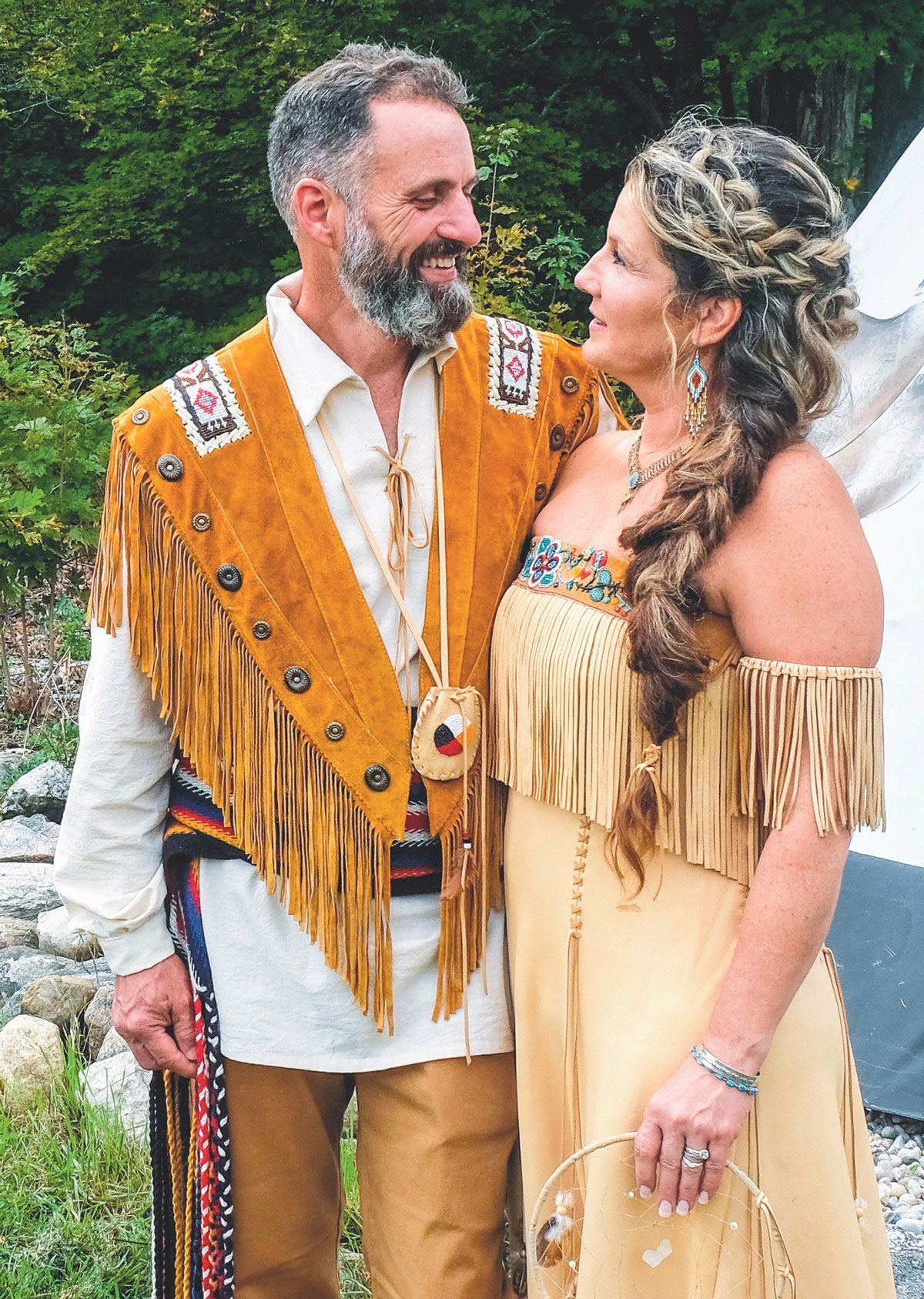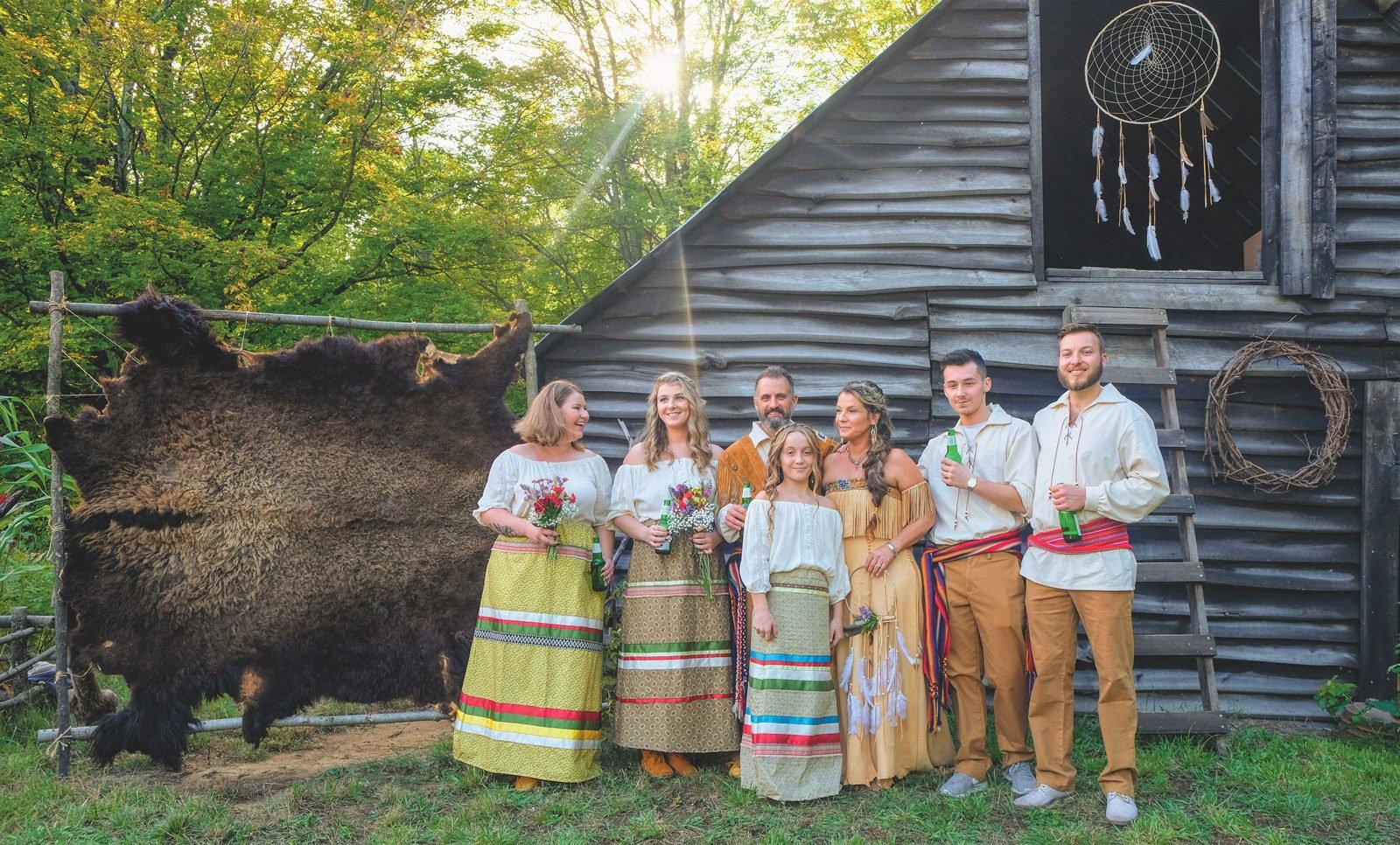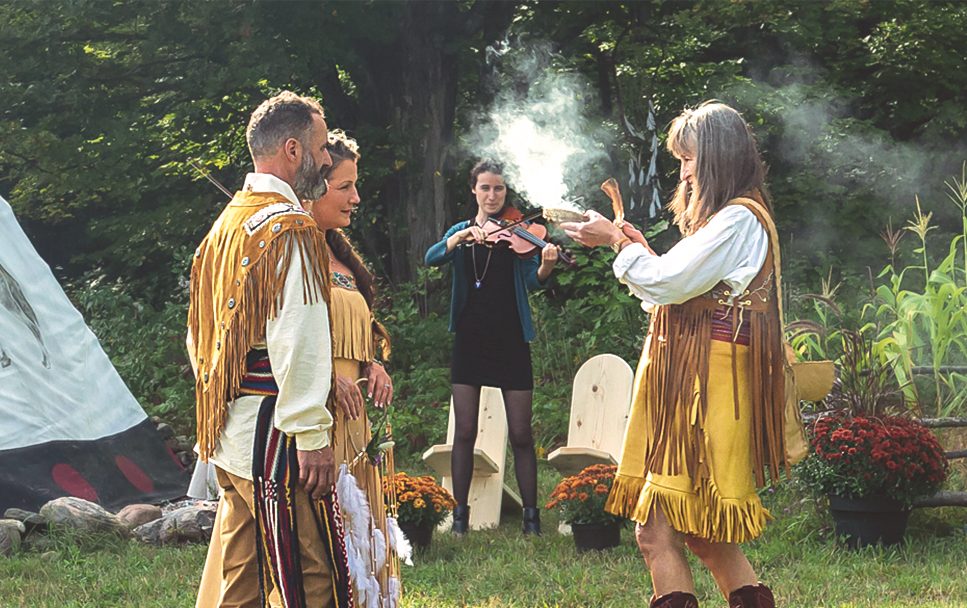
What a Traditional Métis Wedding Looks Like
A Métis wedding seemed only fitting for the atmosphere and living space that my husband Gerard and I had been creating on our new property high on a hill in Penetanguishene, Ontario, overlooking Georgian Bay. More importantly, we are both Métis and have a great appreciation of our ancestry, as well as historical bloodlines which we are proud of.
We moved to “Hill Top Farm” in 2016, here in the “Place of the rolling white sands”—which is what the Algonquin name “Penetanguishene,” devised by the Abenaki tribe, means in English. Our first project was to build a full-size tipi. We cut our own poles, hand peeled and scraped them, and then dried and put up canvas purchased from a supplier, Nomadic Tipis. We use our tipi four seasons of the year, very often, for a variety of activities. After the construction of our tipi was complete, a friend gave me eight buckskins as a “tipi warming” present.
I immediately decided I would honour the hides by using them to make my wedding dress; I also created the Métis-inspired ribbon dresses the girls wore at the wedding.
After the tipi was completed, our little pioneer cabin was born or, rather, reborn. The old cabin came with the property, but it was in rough shape and didn’t have a floor. The wide-plank pine flooring that we installed gave the tired, old shanty a whole new look. We furnished and equipped both the cabin and the tipi with as many historical items and period pieces as we could. On our wedding day, this had the benefit of evoking a feeling of authenticity and warmth, while giving our guests a sense of what life might have been like in a simpler time.
We then began to build a new barn to house our herd of alpacas and my new “fibre shop”—Wild Roots and Twisted Fibers. During the excavation, we found a very old, “pre-colonial contact” Indigenous artifact, a tool by the looks of it. Since we had just constructed our tipi, we thought, wow, we are living on the very land of the Old People, how thrilling! We already knew that Penetanguishene had been widely inhabited by Aboriginals, and that we have a very rich history here in Penetanguishene, but to know we were actually walking in our ancestors’ footsteps, on the very same land, is very special to us. This spot has always felt sacred to me.

A Spiritual Day
For our wedding day, we set up seating in front of our tipi, as well as an archway made of branches from the surrounding woods, under which the ceremony would take place. To finish off our “camp,” we lined our fire pit with a fresh set of stones and hung a huge cast-iron pot for boiling corn. A buffalo hide on a frame was resting near the fire, as though it came from a successful hunt. Finally our setting was complete and the endless stream of ideas that had been flooding my mind were becoming a reality. Based on Métis traditions, we included smudgers, fiddlers, a drummer and singers in the proceedings and everyone in the wedding party wore traditional Métis attire, from ribbon skirts and voyageur shirts to colourful sashes and vests. We wanted to create a feeling for our guests that they would remember fondly.
Before stepping into the forest, our guests were smudged to cleanse and awaken their senses. The walk through the forest, listening to the beat of a drum and beautiful singing, felt so nostalgic and spiritual, as though all the spirits of the forest were awakening as well. At the end of the walk, our guests were greeted by fiddle music and the smell of smoke from the fire. People mingled while awaiting the ceremony and finally the moment arrived when Gerard and I were united in marriage with our family, friends and, yes, our ancestors, there with us, bearing witness. We were wrapped in a blanket and smudged together, as whispers of promises, heaven and rainbows were shared. It was beautiful. Before dinner, my friend Carl, who is 85 and of the Ojibwe First Nation, sang “Amazing Grace” in his mother tongue, adding immeasurably to our shared memories of a wonderful day.
Here are 10 Indigenous authors you should be reading.

A Fulfilling Lifestyle
My husband Gerard is a custom-home contractor and I am confident to say a very reputable one at that. I, on the other hand, stay at home to raise our alpacas for their luxurious fibre. I spin, felt and make yarn to make socks using my antique sock knitting machine!
I have goats that I milk and I make soap. I also forage for roots, weeds and herbs to make healing salves. I tan hides to make leather to then make beaded mittens, moccasins, medicine bags and other items, all with hand-felted alpaca incorporated, of course. We grow lavender to feed our bees, and vegetables to feed us in the winter. We raise meat birds for winter consumption as well, and have laying hens for fresh eggs. We also have access to fresh milk and I make cheese and yogurt.
I have always had a strong desire to lead this lifestyle, ever since I can remember. When I was in my early 20s, I learned how to bead and make moccasins, play the fiddle and step dance. I dabbled in tanning hides, and have made clothing for my children and myself. I have always loved nature and being in the forest. I have always been drawn to Aboriginal culture, and I did not know why. Before I even knew what Métis was, I was already very “Métis.” And I always will be.
Next, check out the incredible work of Métis artist Timothy Mohan.